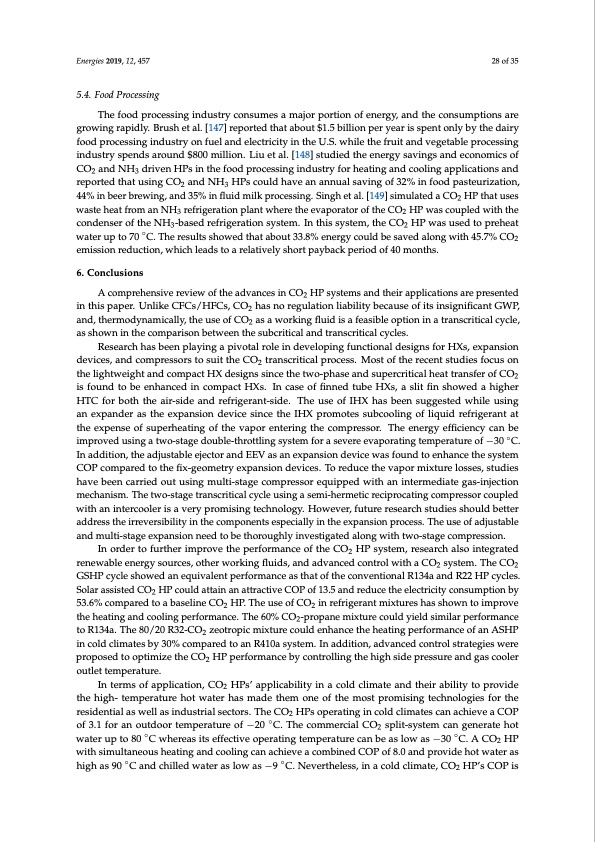
PDF Publication Title:
Text from PDF Page: 028
Energies 2019, 12, 457 28 of 35 5.4. Food Processing The food processing industry consumes a major portion of energy, and the consumptions are growing rapidly. Brush et al. [147] reported that about $1.5 billion per year is spent only by the dairy food processing industry on fuel and electricity in the U.S. while the fruit and vegetable processing industry spends around $800 million. Liu et al. [148] studied the energy savings and economics of CO2 and NH3 driven HPs in the food processing industry for heating and cooling applications and reported that using CO2 and NH3 HPs could have an annual saving of 32% in food pasteurization, 44% in beer brewing, and 35% in fluid milk processing. Singh et al. [149] simulated a CO2 HP that uses waste heat from an NH3 refrigeration plant where the evaporator of the CO2 HP was coupled with the condenser of the NH3-based refrigeration system. In this system, the CO2 HP was used to preheat water up to 70 ◦C. The results showed that about 33.8% energy could be saved along with 45.7% CO2 emission reduction, which leads to a relatively short payback period of 40 months. 6. Conclusions A comprehensive review of the advances in CO2 HP systems and their applications are presented in this paper. Unlike CFCs/HFCs, CO2 has no regulation liability because of its insignificant GWP, and, thermodynamically, the use of CO2 as a working fluid is a feasible option in a transcritical cycle, as shown in the comparison between the subcritical and transcritical cycles. Research has been playing a pivotal role in developing functional designs for HXs, expansion devices, and compressors to suit the CO2 transcritical process. Most of the recent studies focus on the lightweight and compact HX designs since the two-phase and supercritical heat transfer of CO2 is found to be enhanced in compact HXs. In case of finned tube HXs, a slit fin showed a higher HTC for both the air-side and refrigerant-side. The use of IHX has been suggested while using an expander as the expansion device since the IHX promotes subcooling of liquid refrigerant at the expense of superheating of the vapor entering the compressor. The energy efficiency can be improved using a two-stage double-throttling system for a severe evaporating temperature of −30 ◦C. In addition, the adjustable ejector and EEV as an expansion device was found to enhance the system COP compared to the fix-geometry expansion devices. To reduce the vapor mixture losses, studies have been carried out using multi-stage compressor equipped with an intermediate gas-injection mechanism. The two-stage transcritical cycle using a semi-hermetic reciprocating compressor coupled with an intercooler is a very promising technology. However, future research studies should better address the irreversibility in the components especially in the expansion process. The use of adjustable and multi-stage expansion need to be thoroughly investigated along with two-stage compression. In order to further improve the performance of the CO2 HP system, research also integrated renewable energy sources, other working fluids, and advanced control with a CO2 system. The CO2 GSHP cycle showed an equivalent performance as that of the conventional R134a and R22 HP cycles. Solar assisted CO2 HP could attain an attractive COP of 13.5 and reduce the electricity consumption by 53.6% compared to a baseline CO2 HP. The use of CO2 in refrigerant mixtures has shown to improve the heating and cooling performance. The 60% CO2-propane mixture could yield similar performance to R134a. The 80/20 R32-CO2 zeotropic mixture could enhance the heating performance of an ASHP in cold climates by 30% compared to an R410a system. In addition, advanced control strategies were proposed to optimize the CO2 HP performance by controlling the high side pressure and gas cooler outlet temperature. In terms of application, CO2 HPs’ applicability in a cold climate and their ability to provide the high- temperature hot water has made them one of the most promising technologies for the residential as well as industrial sectors. The CO2 HPs operating in cold climates can achieve a COP of 3.1 for an outdoor temperature of −20 ◦C. The commercial CO2 split-system can generate hot water up to 80 ◦C whereas its effective operating temperature can be as low as −30 ◦C. A CO2 HP with simultaneous heating and cooling can achieve a combined COP of 8.0 and provide hot water as high as 90 ◦C and chilled water as low as −9 ◦C. Nevertheless, in a cold climate, CO2 HP’s COP isPDF Image | Recent Advances in Transcritical CO2 (R744) Heat Pump System

PDF Search Title:
Recent Advances in Transcritical CO2 (R744) Heat Pump SystemOriginal File Name Searched:
energies-12-00457.pdfDIY PDF Search: Google It | Yahoo | Bing
CO2 Organic Rankine Cycle Experimenter Platform The supercritical CO2 phase change system is both a heat pump and organic rankine cycle which can be used for those purposes and as a supercritical extractor for advanced subcritical and supercritical extraction technology. Uses include producing nanoparticles, precious metal CO2 extraction, lithium battery recycling, and other applications... More Info
Heat Pumps CO2 ORC Heat Pump System Platform More Info
| CONTACT TEL: 608-238-6001 Email: greg@infinityturbine.com | RSS | AMP |